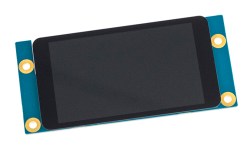27
I caught up with Federico Musto, President and CEO of Arduino SRL, at the 2016 Bay Area Maker Faire. Their company is showing off several new boards being prepared for release as early as next month. In partnership with Nordic Semi and ST Microelectronics they have put together some very powerful offerings which we discuss in the video below.
 The new boards are called Arduino Primo, Arduino Core, Arduino Alicepad, and Arduino Otto.
The new boards are called Arduino Primo, Arduino Core, Arduino Alicepad, and Arduino Otto.
The first up is the Primo, a board built to adhere to the UNO form factor. This one is packing an interesting punch. The main micro is not an Atmel chip, but a Nordic nRF52832 ARM Cortex-M4F chip. Besides being a significantly fast CPU with floating-point support, the Nordic IC also has built-in Bluetooth LE and NFC capabilities, and the board has a PCB antenna built in.
On an UNO this is where the silicon would end. But on the Primo you get two more controllers: an ESP8266 and an STM32F103. The former is obvious, it brings WiFi to the party (including over-the-air programming). The STM32 chip is there to provide peripheral control and debugging. Debugging is an interesting development and is hard to come by in the Arduino-sphere. This will use the OpenOCD standard, with platformio.org as the recommended GUI.
The same nRF52 microcontroller is present on the Arduino Core and the Alicepad, which are targeted at wearable electronics. The circular form factor of the Alicepad mimics the familiar sewable form of the Lilypad.


Arduino’s other offerings are where the horsepower really gets crazy. The Otto board boasts a gigantic STM32F469: a 169-pin ARM Cortex-M4F clocked at 180 MHz. The chip has a ridiculous assortment of built-in peripherals, and you’re not likely to run out of either pins or CPU cycles. It’s also got a hardware graphics accelerator, so it’s no surprise to find that the Otto has a DSI-IF connector on the back that is designed to plug into the LCD screen also being demonstrated at the event: a capacitive touch 480×800 display. The Otto also includes an ESP8266 to provide WiFi (why not, right?).
There are a few question marks in my mind on this one. First off, the Otto and the LCD have a product-family designator of “Star” which will be assigned to all the boards that feature the STM controllers. This seems a bit confusing (Star Otto, Star LCD, etc) but I guess they want to differentiate them from the “normal” Arduini. But are these devices becoming too complex to bear the Arduino name? Maybe, but the UNO is always going to be there for you and the new boards give you access to newer and more powerful features. Whether or not this complexity can be easily harnessed will depend on the software libraries and the IDE. After all, I think Donald Papp made a great point earlier in the week about the value of Arduino comfort in custom electronic work.
The Lawsuits
Finally, I asked Federico if there is any news about the Arduino versus Arduino trademark litigation. He spoke with us almost a year ago on the topic, but he had no new information for us at this point. (The US court case may be ruled on as early as July of this year, so there’s probably not much he could say, but I had to try.)
Federico spoke a little bit about the conflict between the two Arduinos, and said that it was brewing inside the company long before he got there. And it does appear that both companies calling themselves Arduino are trying to outdo each other with new boards and new initiatives, and going in different directions. If there is a bright side, it’s that this competition may end up building us better hardware than a single company would, because both are making bets on what will put them out ahead of the game.
Filed under: Arduino Hacks, cons, Interviews


